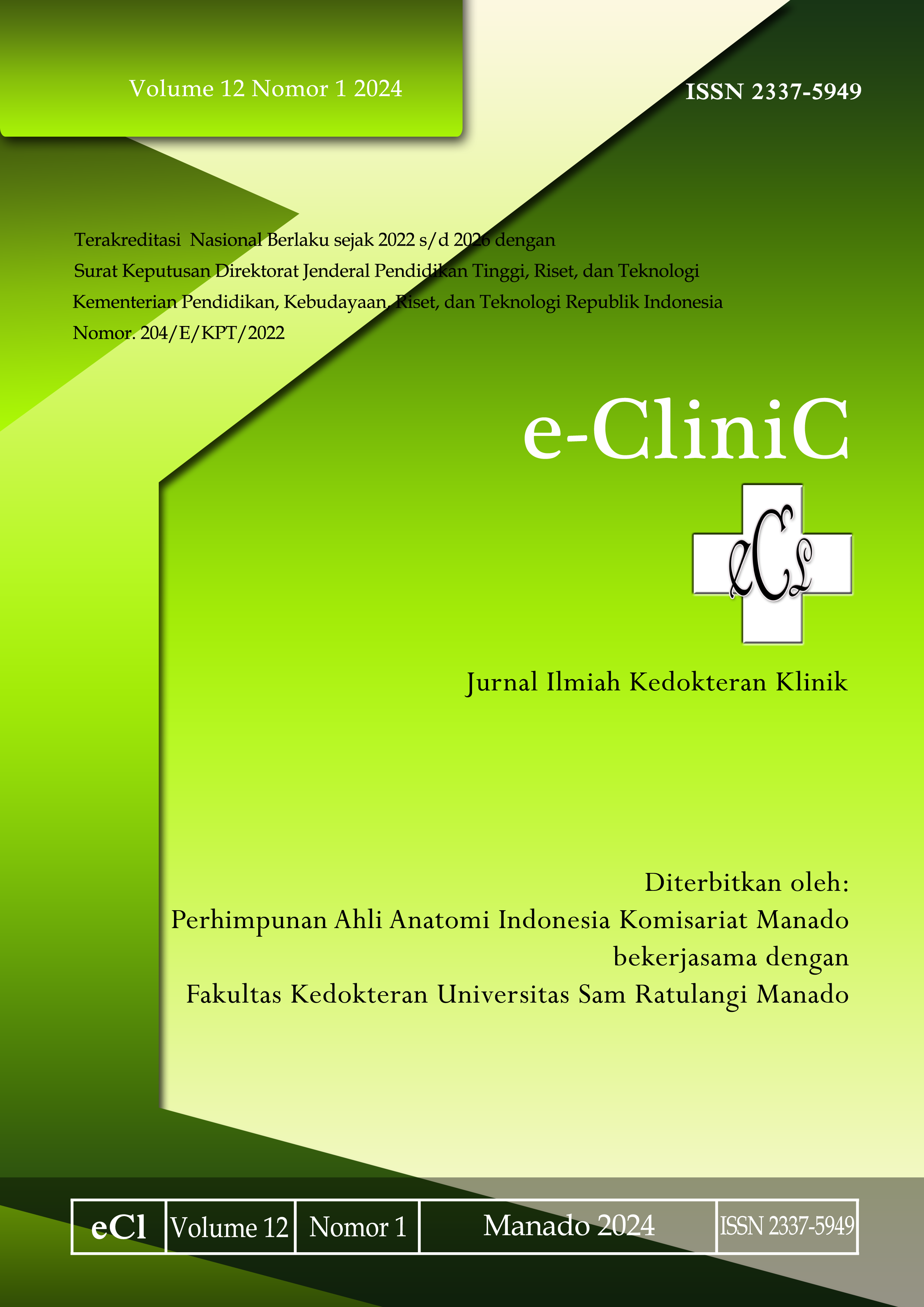Sternotomy or Thoracotomy: Which One?
DOI:
https://doi.org/10.35790/ecl.v12i1.46259Abstract
Abstract: Penetrating injuries to the chest present a frequent and challenging problems. Median sternotomy and thoracotomy are two choices to explore any trauma to the chest. We report a 37-year-old man with wound and pain in his left chest due to being stabbed with a knife one hour ago. On physical examination, an open wound measured 5x1.5 cm as high as the third rib parallel to the left parasternal line, the edges of the wound bed were flattened by the periosteum. Laboratory examination showed leukocytosis. FAST showed an important left pleural effusion and pericardial fluid. CTA study showed the presence of air in the anterior mediastinum and the left pleural cavity. In the fifth intercostal space, a left anterolateral thoracotomy was performed and 800 ml of blood was evacuated from the left chest. The left lung was lowered to open the pericardium, which caused a further drop in blood pressure; then, the pericardium was opened and a blood clot (1500 ml) was removed. An epicardial wounds were found on the anterior surface of the right ventricle. The left anterior coronary artery was actively bleeding. The hemorrhagic lesion was stitched with 4.0 polypropylene reinforced with a Teflon strip. The patient recovered uneventfully on the sixth postoperative day. During the 14-month follow-up, the patient was fine and back to work. In conclusion, surgeon must be able to decide the technique of approach in the operating room considering the site of injury and the presence of involving organ. Thoracotomy patient can also receive median sternotomy if the cardiac injuries could not be repaired through thoracotomy. In addition, some patients with median sternotomy also received additional thoracotomy due to their pulmonary injuries.
Keywords: penetrating injuries; thoracotomy; sternotomy; cardiac injury
References
Gao JM, Gao YH, Wei GB, Liu GL, Tian XY, Hu P, et al. Penetrating cardiac wounds: principles for surgical management. World J Surg. 2004;28(10):1025-9. Doi: 10.1007/s00268-004-7523-0.
Seamon MJ, Haut ER, Van Arendonk K, Barbosa RR, Chiu WC, Dente CJ, Et al. An evidence-based approach to patient selection for emergency department thoracotomy: a practice management guideline from the Eastern Association for the Surgery of Trauma. J Trauma Acute Care Surg. 2015;79(1):159-73. Doi: 10.1097/TA.0000000000000648.
Burack JH, Kandil E, Sawas A, O’neill PA, Sclafani SJA, Lowery RC, et al. Triage and outcome of patients with mediastinal penetrating trauma. Ann Thorac Surg. 2007;83(2):377-82. Doi: 10.1016/j. athoracsur.2006.05.107
Degiannis E, Loogna P, Doll D, Bonnano F, Bowley BM, Smith MD. Penetrating cardiac injuries: recent experience in South Africa. World J Surg. 2006;30(7):1258- 64. Doi: 10.1007/s00268-005-0463-5.
Gunay C, Cingoz F, Kuralay E, Demirkilic U, Tatar H. Surgical challenges for urgent approach in penetrating heart injuries. Heart Surg Forum. 2007;10(6):E473-7. Doi: 10.1532/HSF98.20071098.
Kong VY, Sartorius B, Clarke DL. The accuracy of physical examination in identifying significant pathologies in penetrating thoracic trauma. Eur J Trauma Emerg Surg. 2015;41(6):647-50. Doi: 10.1007/s00068-014-0484-6.
Ivatury RR, Nallathambi MN, Roberge RJ, Rohman M, Stahl W. Penetrating thoracic injuries: in-field stabilization vs. prompt transport. J Trauma. 1987;27(9):1066-73.
Chang B, Tucker WD, Burns B. Thoracotomy. In: StatPearls. Treasure Island (FL): StatPearls Publishing; 2022.
Van Waes OJF, Van Riet PA, Van Lieshout EMM, Hartog DD. Immediate thoracotomy for penetrating injuries: ten years’ experience at a Dutch level I trauma center. Eur J Trauma Emerg Surg. 2012;38(5):543–51. Doi: 10.1007/s00068-012-0198-6.
Beşir Y, Gokalp O, Eygi B, Iner H, Peker I, Gokalp G, et al. Choice of incision in penetrating cardiac injuries: Which one must we prefer: thoracotomy or sternotomy? Ulus Travma Acil Cerrahi Derg. 2015;21(4):266–70. Doi: 10.5505/tjtes.2015.52882.
Downloads
Published
How to Cite
Issue
Section
License
Copyright (c) 2023 Adrian Tangkilisan, Wega Sukanto, Christha Tamburian, Gerald R. Lolongan

This work is licensed under a Creative Commons Attribution-NonCommercial 4.0 International License.
COPYRIGHT
Authors who publish with this journal agree to the following terms:
Authors hold their copyright and grant this journal the privilege of first publication, with the work simultaneously licensed under a Creative Commons Attribution License that permits others to impart the work with an acknowledgment of the work's origin and initial publication by this journal.
Authors can enter into separate or additional contractual arrangements for the non-exclusive distribution of the journal's published version of the work (for example, post it to an institutional repository or publish it in a book), with an acknowledgment of its underlying publication in this journal.
Authors are permitted and encouraged to post their work online (for example, in institutional repositories or on their website) as it can lead to productive exchanges, as well as earlier and greater citation of the published work (See The Effect of Open Access).







